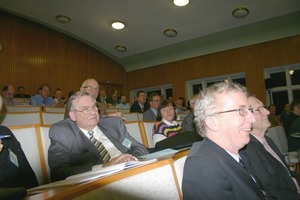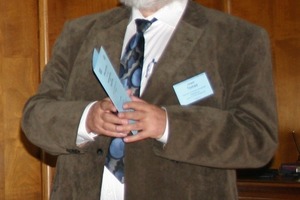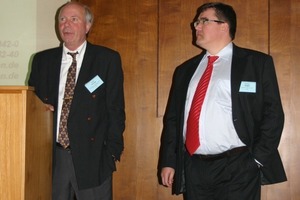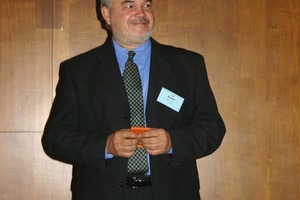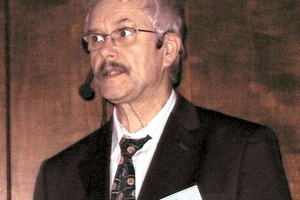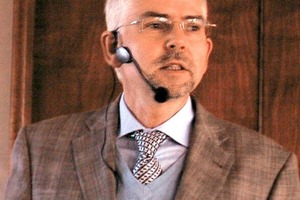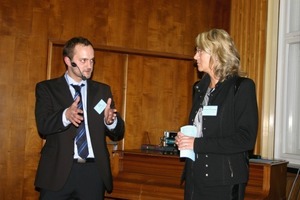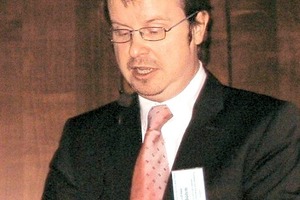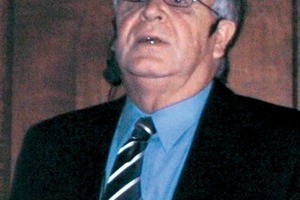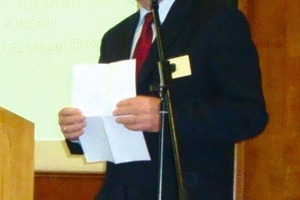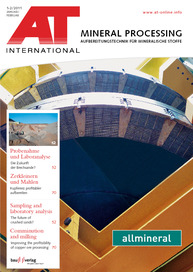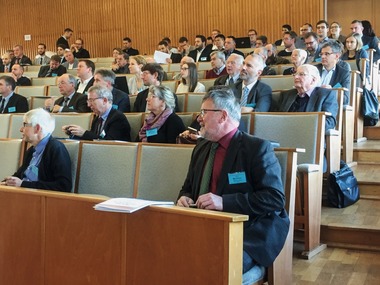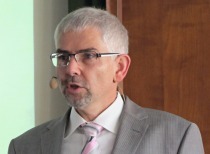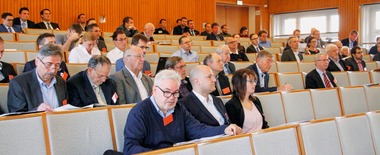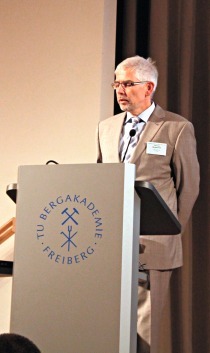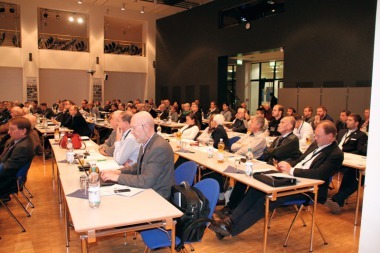Primary and secondary minerals preparation
Preparation und recycling, Freiberg/Germany (10.-11.11.2010)The annual “Preparation und Recycling” conference organized by the UVR e.V. and FIA e.V. Freiberg associations, with significant involvement by UVR-FIA GmbH, has been held in the second week of November in the auditorium of the Center for Business Incubation and Innovation (GIZEF). The response to this year‘s event was outstanding (Fig. 1), as is documented by the more than 150 specialist participants from Germany and other European countries. Numerous posters and presentations were shown, in addition to twenty-five papers presented by well-known representatives of commercial companies and research institutions. The prime focuses of the 2010 conference included, current problems in primary and secondary minerals preparation and in the recycling of useful contents. A period for discussion was left open after each of the papers. Particularly worthy of mention is the fact that the senior German preparation practitioner, Prof. Heinrich Schubert, also very actively contributed valuable notes and remarks.
Following the opening address by UVR-FIA GmbH Freiberg CEO, Dr.-Ing. Morgenroth, the first series of papers examined new discoveries and perceptions in the field of grinding. Prof. Tomas (Fig. 2) and co-authors (Otto-von-Guericke University of Magdeburg, Dept. of Mechanical and Process Engineering) reported in their address entitled “Comminu-tion for production of ultra-fine products” on the problems involved in the production of nano-particle suspensions, assessing precipitation crystallization and comminution against one another. The avoidance of agglomeration in the production of ultra-fine to nano-scale particles is an essential microprocess in both of these operations. Electrolytes, the action of which is based on the repulsion of like-charged electrochemical double-layers between the adjacent particle surfaces, are used here. As an alternative, polar/non-polar structured surfactant molecules, which are adsorbed on the surfaces, and the non-polar hydrocarbon chains of which extend into the dispersant and, as “spacers” between the adjacent particles, cause steric repulsion, can be added. The selection of a suitable mill design depends on materials properties such as hardness, geometry and particle size, and is also influenced by the requirements made on the end product in terms, for example, of fineness, particle geometry, production rate and purity.
Energy-saving grinding of hard inorganic substances and ultra-fine mineral meals, and also the potential for dry production of submicron-range particles, was the topic examined by the paper entitled “Agitator ball mill with integrated classifier for ultra-fine dry grinding” presented by Dr. Stein and Dipl.-Ing. Droop (Hosokawa Alpine AG, Augsburg). These mills, operated with tiny grinding beads of between 1 and 10 mm in diameter, are suitable for ultra-fine grinding down into the submicron range, since they permit the generation of high load energies and, thanks to the large number of small grinding elements, the loading frequency necessary for cost-efficient operation. All ultra-fine grinding mills are operated in circuit with a classifier. Modern grinding and classifying technology makes it possible to produce particle-size distributions with an oversize particle fraction of 2 to 3 µm. Various types are available, with a fixed or recirculating grinding-bead bed, and with differing classifier configurations. Thanks to its integrated ultra-fine classifier, the recently developed “Pulvis” agitated-media mill-classifier combines a remarkably contained design with compact system peripherals.
Dipl.-Ing. Ebner (EMT Consulting, Vienna) reported on many years of experience in the design and operation of “Wet grinding systems for the production of absorber suspension for wet flue-gas desulfurization installations in high-capacity power generating plants”. The target is, in this context, the generation of high-reactivity dispersions for removal of SO2, with the minimum possible residual CaCO3 content in the FGD lump gypsum yielded, in order to achieve qualities permitting the use of this product as a building material. Suspension finenesses of P80 = 20-25 µm and constant suspension densities of 25-30 %-wt. solids are achieved with grinding-circuit configurations involving single or double-stage cyclone classifying, with the inclusion of pre-crushers where necessary. The various potentials were discussed, citing specific examples of operational installations. Improved hydrocyclone technology and more accurate methods of measuring suspension density permit more efficient technologies in this context.
The address by Dipl.-Ing. Kroog (BT-Wolfgang Binder GmbH, Redwave Sorting Technology, Gleisdorf /Austria) on “Redwave® sorting technology” outlined experience up to now in sensor-assisted minerals sorting and highlighted the potentials of the latest generation of automatic sorting machines, with particular emphasis on near-infrared (NIR) and X-ray fluorescence detection. Minerals, precious stones and ores are still frequently sorted manually in industry, particularly in China, India and South America. Sorting machines and sensor technologies achieve automatic separation of dry minerals and tailings, as an alternative to conventional “wet” processing.
Deposits of practically all important industrial minerals are becoming ever more difficult to access, and are also increasingly poorer and less homogenous. Dipl.-Ing. (FH) Zeiger (Mogensen GmbH & Co. KG, Wedel) provided a “Technical and economic analysis of the Mogensen MikroSort optical sorting system for preparation of industrial minerals”, using which operating costs can be reduced extremely effectively, system productivity enhanced, and product quality significantly improved. The general principles of the method, and also the special features relevant in the case of various materials, were discussed. A particular focus in this context is the pretreatment of the feed materials, which is necessary for achievement of accurate and repeatable results, and is implemented by means of comminution, screening, washing and/or compressed-air cleaning appropriate to attain liberation of the minerals, in order to optimize optical differentiation. This was underlined by specific examples of technological applications for the preparation of calcite, magnesite and burnt lime (Fig. 3).
Dipl.-Ing. Bruder (Derrick Corp., Hirschau) provided information on the „Use of Derrick mechanical screens in grinding circuits“ (Fig. 4). Derrick Corp. is a producer of wet and dry mechanical screens, specializing in the classifying of all types of solid fines. Special mechanical-screen designs, high frequencies at low amplitudes, combined with large open screen surface areas featuring so-called pyramid screen decks consisting of PUR, permit compact screen design and assure high productivity and good product qualities.
A new technology for recycling of thin-film photovoltaic modules on a cadmium-telluride (CdTe) and copper-indium-disulfide/selenide (CIS) basis has been developed in the context of a project financially supported by the German Federation of Industrial Research Associations (AiF), and conducted jointly by GPI Lübbenau, Division IV.3 Waste Treatment and Remedial Engineering of the BAM Berlin materials-testing institute and the Department of Mechanical, Electrical and Industrial Engineering of the BTU Cottbus. A paper by Dr. Wolf (GP innovation GmbH, Lübbenau) and co-authors from the participating institutions firstly reported on the “Recycling of thin-film photovoltaic modules using vacuum-suction blasting” (Fig. 5). Here, mechanical removal of the semi-conductor layers is accompanied by simultaneous decontamination of the glass substrate and mechanical/pneumatic separation and concentration of the materials contained in the semi-conductor films.
This process is augmented by a further stage, that of “Wet mechanical recycling of thin-film photovoltaic modules by means of flotation”, on which Dipl.-Ing. Andrea Bredow and co-authors (BAM Berlin) provided information. Flotation is applied to the materials extracted during suction blasting and dry mechanical separation on a plate-type air classifier, cyclone and industrial vacuum cleaner in the test facility designed by GPI and BTU. These take the form of mixtures of blasting agents, glass substrate and semiconductor/contact materials. The flotation tests were performed using a laboratory flotation installation featuring a rotor/stator system with an integrated finger agitator. Preliminary experiments indicated that potassium amylxanthate (PAX) was the most suitable flotation agent. Even single-stage flotation achieved relatively good concentration of semiconductor and contact elements. The results of two-stage flotation demonstrated that the concentration of the indium, selenium and copper values increased continuously during the course of the processing stages, from the input material via the first and second flotation stage, and that the output of the second flotation stage in each case exhibited twice the concentration of the feed material. These project results make the prospects for economic utilization of this newly developed technology promising.
In his paper on “Investigations of flotation-based preparation of minerals”, the CEO of UVR-FIA GmbH Freiberg, Dr.-Ing. Morgenroth (Fig. 6), reported on selected results of industrial research performed at UVR-FIA GmbH in the last five years. The preparation of mineral resources has always been one of this company‘s main fields of activity. Decades of work on process development and process-engineering support of preparation plants has created a rich fund of detailed knowledge and extensive experience with the flotation-based preparation of non-ferrous metal ores (cassiterite, polymetallic sulfide ores, gold ores) and industrial minerals (spars, dolomite, limestone, quartz minerals, etc.). This know-how also includes the selection of flotation chemicals and the application of the results of laboratory flotation tests to the commercial-scale flotation of minerals resources.
The address by Dr.-Ing. Jungmann (CALA Aufbereitungs-technik GmbH & Co. KG, Herzogenrath), entitled „Preparation of iron and steel plant slag (SPS): Do dry processes offer potentials for better values recovery?“ examined a topical problem in the utilization of secondary and recycled feed materials. Some 6 to 7 million t of iron and steel plant slag occur annually in Germany. Of this quantity, 65 to 70 % is used at a relatively low-value level as building materials, while around 10 % continues even now to be landfill dumped. The example of a slag treatment route employing only dry methods was used to illustrate the potentials available in terms of metal yield, on the one hand, and on the valorization side, on the other. The aim here is that of harmonizing under the best possible ecological and economic conditions the successive stages of optimum slag tipping, selective slag breakdown, sorting on the basis of sensor technology, density-based separation, and utilization of the byproduct (slag) as a building-material additive.
In the paper on “Modeling and simulation of a waste preparation plant for the production of secondary fuels”, Dipl.-Ing. Platzk (Fig. 7) and Prof. Kuyumcu (Specialist Group Mechanical Process-Engineering and Preparation, Technical University of Berlin) drew attention to the exceptional difficulty, in view of the heterogeneity of the material mixture and the large number of influencing factors, of mathematically describing the processes involved. Modern solids-flow-chart simulators have been used for the development and programming of models, with the inclusion of the basic mechanical processes of classifying and sorting (air classifying, magnetic and eddy-flow separation) and comminution (impact comminutors) and agglomeration (press agglomeration). To permit modeling, the dispersed material system is classified into a liquid and a solid phase, the latter being subdivided into a number of groups of high-calorific-value and inert substances. Non-distributed and distributed features, and features independent of each other, are assigned to each substance group in an attribute matrix. The supra-substance-group features are total mass flow, temperature and pressure. Calorific value is used as the quality criterion for the secondary fuel. The simulation computation for the system as a whole resulted in the determination of the quantity and quality of the secondary fuel produced, and of other preparation process products. The variation of process parameters indicated significant factors influencing product quality and therefore the potential for optimization of the process as a whole.
The paper presented by Dr.-Ing. Suhendra and co-authors (Federal Institute for Materials Research and Testing [BAM], Berlin) on the “Co-granulation of sewage sludge ash, biomass ash and industrial byproducts for production of NPK fertilizers” examined the recovery of phosphate from waste-water treatment ash and its utilization as a fertilizer with high phosphorus, nitrogen and potassium contents. The focus was on the granulation of the products necessary for their transportation and utilization. In this process, not only ash from sewage treatment, but also other industrial byproducts (biomass ash and ammonium sulfate) are used as sources of the elements P, N and K. Granulation takes place in intensive mixers, the quality of the granulate being evaluated on the basis of the principal-component composition and mechanical strength.
Dipl.-Ing. Steiger (Flottweg AG, Vilsbiburg) reported on the “Use of decanting centrifuges in the preparation and recycling industry”. The machines bearing the Decanter, Tricanter® (three-phase decanter) and Sorticanter® trade names are centrifuges for the mechanical separation of mixtures consisting of solids and liquids of differing densities which are insoluble in each other. In the preparation and recycling industry, and in the case of mechanical separation systems, in particular, the quality of separation is in many instances definitive for the efficiency and cost-effectiveness of the processes used. Decanters are utilized for continuous removal of suspended solids from liquids, for the clarification of liquids and for the classifying of fine pigments, etc. A Tricanter® (three-phase decanter) permits continuous three-phase separation, i.e., the simultaneous separation of two liquids which are not soluble in each other, and a solid phase. The precondition is that the liquids must be of differing densities and that the solids are present as the specifically “heaviest” phase. The Sorticanter® is a special centrifuge for the continuous removal of solids of differing densities from a liquid. Here, one solid phase must have a higher, and the other a lower, density than the liquid phase. Examples of applications in the preparation and recycling industry, such as the preparation of drilling muds, production of pigments and fillers/extenders, the concentration of suspensions containing ores and spoils and others, were examined.
The address by Dr. Sandra Birtel (Inst. of Mineralogy, TU Bergakademie Freiberg mining and technology academy), with the title “Geometallurgy – for the sustainable utilization of mineral resources”, provided the starting point for an interesting discussion on this interdisciplinary line of research, up to now little known in Germany under this heading, in the intersecting fields of the geo-sciences, minerals preparation, metallurgy and materials science. The target in this context is an interchange of the relevant data between all process stages, accompanied by a geological assessment of the deposit mined, in order to achieve optimum exploitation of its values content. The main hurdles on the road to the implementation of geometallurgy in the mineral resources industry take the form of the pronounced interdisciplinary rivalries in this industry, which result in significant failures in communications between the representatives of the individual process stages. In many cases, the quantitative process relevant data records on the mineralogy and structure of the resources (ores) and the preparation products are lacking. Not only concentration, but also locally varying associations of minerals and structure, determine the optimum preparation route, the necessary energy input, and the economically recoverable yield. The aim of geometallurgy is that of generating and utilizing statistically representative data records on mineralogy and structure in the context of geometallurgy, in order to optimize mining planning and implementation, increase ore mineral yield, minimize energy consumption (for crushing and grinding, in particular), maximize the availability of commercial-scale mining and preparation facilities and equipment, and assure environmentally safe disposal of the residues and byproducts.
The address on “Rare metals of strategic significance – life cycle strategies” by Dr. Palitzsch (Loser Chemie GmbH, Hainichen) was devoted to the problems of the long-term assurance of mineral resources supplies with adherence to environmental aspects, the fundamental precondition being efficient and environmentally safe use of materials, from resources recovery up to and including waste management (Fig. 8). The “Life cycle strategies and recycling for rare metals of strategic importance” innovation forum supported by the federal education and research ministry (BMBF) in cooperation with the Free State of Saxony aims to develop appropriate waste-recycling strategies, in order to contribute to the responsible use of finite resources. Principle interest in this context is directed toward innovative products, such as thin-film CdTe- or indium-based photovoltaic waste, rare earths in illuminants, energy-saving bulbs and catalysts (platinum group). Attention was also drawn to other Loser Chemie GmbH fields of activity, including, for example, the production, development and marketing of water-chemistry products and the development of processes for waste and waste-water treatment.
Due to the limited scope for expansion of internal blast furnace volume, iron ore concentrates with a higher Fe content were necessary in the context of the increase in steel production capacity at voestalpine AG‘s Linz (Austria) steelworks. Dipl.-Ing. Dr. mont. Böhm (Chair of Mineral Processing, Leoben University of Mining and Technology) thus reported on “Pelletizing of magnetic products from calcined siderite: fundamentals, experimental and test technology, results” (Fig. 9). Siderite is selectively converted to ferromagnetic ferrite in a temperature-controlled thermal process (the “Steiner” process), exploiting the differing carbonate-calcination temperatures of the value mineral, siderite (Fe, Mg, Ca, Mn)(CO3), containing 42 % Fe, and the gangue mineral, ankerite (Mg, Ca, Fe, Mn)(CO3), containing 12 % Fe, while the ankerite remains paramagnetic. The ankerite, reduced to a particle size of < 0.8 mm, can then be removed relatively easily by means of dry low field magnetic separation. The magnetic concentrate, with an Fe content of 54 %, is suitable in this dispersity neither for transportation nor for charging in the blast furnace, however. Pelletization yields a usable product. The test results obtained up to now were presented, and the influence of additives (coke), organic and inorganic binders, and water requirements were discussed.
Answers to the questions of the mineralogical composition, mineral interpenetration and properties – such as density, magnetizability and surface properties – of the materials to be separated are of the greatest importance in process selection. Of particular significance in this context is “Mensurational determination of porosity in the context of feed-material characterization”, on which Dipl.-Ing. Dr. mont. Stadtschnitzer and Prof. Dr. Flachberger (Chair of Mineral Processing, Leoben University of Mining and Technology) reported. The true (or “particle”) density of any material relates to the pore-free substance, while the bulk (or “apparent”) density includes in the calculation the entire volume of any porosity present, with the consequence of lower values compared to true density. The entire pore volume is sub-classified into closed and open porosity, fluids being able to infiltrate into the latter. The helium gas pycnometer can be used to determine the volume of particles including their closed porosity. The determination of true density necessitates complete extraction by means of comminution. Where apparent density is to be found, the enclosing volume of the porous particles must be determined. A pycnometer (e.g. the GeoPyc 1360), which, as a “fluid”, does not penetrate into the pores of the sample, is suitable for this purpose. These measuring methods were used, citing the example of a European fluorite/barytes deposit, to ascertain in some cases high porosity readings, which explain the fluorite misplacings occurring in density-based coarse-particle sorting. The investigations into density-based sorting of fine particles indicate that the influence of porosity is also extremely pronounced in this particle size range. The installation upstream of an air flow classifier did, for example, improve the extraction of barytes from the sinks, but the separation of fluorite and gangue remained impossible in the case of porous fluorite particles, despite optimum feed-material preparation. Impressive results were achieved in the fine-particles range using electrostatic separation as an alternative separation method, however.
Dr.-Ing. Alexandra Pehlken (University of Bremen) presented the topic of “Secondary mineral resources as deposits – a contribution by preparation processes to sustainability”, focused on the modeling and prediction of secondary mineral resources recovered from recycling processes. The problems involved were illustrated using the example of „open loop“ recycling, in which secondary material flows are not returned to the original application (e.g. life-expired tyres to new tyres), but instead used in new applications (life-expired tyres to artificial lawns). The properties of the individual material flows can be used to determine the further uses, which may be classified as “upcycling” or “downcycling”, depending on the quality of the material flows.
Dipl.-Ing. Heinicke and co-authors (Polysius AG, Beckum) provided in their address entitled “Investigation of preparation by means of the minerals liberation analyzer” information on this new analytical method. Scanning electron microscope (SEM) images are made of a specimen encased in epoxy resin and then sectioned and polished. The grey scales of the back-scatter electron (BSE) image are then analyzed, and an X-ray spectrum of each particle recorded by means of an EDX detector and evaluated using a high-performance software package. This analysis permits the derivation of information on the overall mineralogical composition of the specimen, on its individual chemical composition, on the distribution of the elements in the minerals, on the mean and mineral-specific particle size distribution, on the adhesion of individual minerals to one another, and on the degree of extraction of the value mineral. The paper reported on various applications for this method, errors in analytical methodology, and on selected experimental results.
Prof. Dr.-Ing. Gock (Fig. 10) and his co-authors from the Technical University of Clausthal, the CUTEC Institute, Clausthal, and ProGENF UG, of Werdohl, examined a new “Process for bypass preliminary dezincification of steel scrap”. Shortages in the supply of alloying-element-free steel scrap have occurred, particularly in the foundry industry, as a result of the global introduction of the anti-corrosion protection of low-alloy automotive strip by means zinc-plating. A new acid-based preliminary dezincification process has been developed, and a pilot plant with a throughput of 1 t/h constructed and commissioned, at the CUTEC Institute in the context of a joint project (Reference: 033R021) supported by the BMBF ministry and conducted in association with partners from the fields of research, the automotive industry, zinc metallurgy, the scrap metal trade, the foundry industry and plant engineering. Dezincification is accomplished using process acid originating from zinc metallurgy which, after lading with > 110 g/l of zinc, is returned to the primary zinc recovery process. Bypass preliminary dezincification, which takes place at ambient temperature, achieves energy-savings of around 74 % and a reduction in CO2 emissions of some 88 % compared to conventional dezincification in the electric steelmaking plant with subsequent enrichment via the rotary zinc kiln process.
Various waste mixtures, and filter dusts, ash and electronics shreddings, in particular, contain base and noble metals at various concentrations and in various particle sizes, it not having always proven possible to achieve the targeted degree of recovery in the case of the fine particles (< 1 mm) up to now. Dipl.-Ing. Bräumer (mbb Ingenieurbüro für Aufbereitungstechnik, Bendorf) demonstrated that a cost-saving, compact and low-wear technology has been developed in the form of the „mbb – FMR three-stage process for recovery of fine metal particles“, achieving lower metal losses, relief of the burden on filters during melting down, and higher melting productivity rates. Extraction by means of fine wet grinding in a vertical jig, which very largely breaks down the bonds and comminutes the fibers using grinding elements similar to those used in a vibrating tube mill, takes place in the first stage. Only this operation permits effective gravity-based separation in the following process stages. Abraded grinding element material is used as dense medium in a closed water circuit. Wet separation using mbb counterflow cyclones (“crossflow cleaners”) occurs in the second stage, with fibers and lights being extracted in the cyclone overflow. In the third stage, multi-gravity separation (MGS) in a rotating pusher-kiln processes the product into a metal concentrate suitable for melting.
Dipl.-Ing. Silge (Haver Engineering GmbH, Meissen) reported on “Agglomeration using pelletizing disks in the primary and secondary feed-materials industry”. An outline of the basic processes involved in build-up agglomeration was followed by an examination of the benefits of the use of pelletizing disks. The process is predominantly used for the preparation of iron ores. Experience in the design, installation and operation of large-scale plants was reported, and illustrated by means of videos. In addition to the use of the process in the ore and minerals industries, there are also advantageous potential applications in the fields, for example, of building materials, fertilizers and filter dusts.
Dr. Narra and co-authors (Chair of Preparation Technology and Biogenic Resources at the Brandenburg University of Technology, Cottbus, the Agency for Renewable Resources, Gülzow and the Leibniz Institute of Agricultural Engineering, Potsdam-Bornim) focused on the “Comparative assessment of various image-analysis systems for determination of the particle-size distribution of comminuted straw and its characteristic influence on the stability and mechanical strength of biomass pellets”. The conversion of biomasses to high-quality fuels necessitates a large number of upstream preparation stages. The ultimate target is the production of high-strength pellets of defined geometry, dimensions, density and mechanical strength, which possess the stability needed for storage, handling and transportation processes, and for conveyance into the combustion chamber. Particle size distribution following comminution is one of the main factors influencing the activation and stability of binder mechanisms during the process of pelletization of rye and wheat straw. The aim should be to produce a fines fraction of around 20 to 40 %, irrespective of the preparation method selected. Greatly divergent measured data were obtained upon comparison of the results of the various image-analysis systems and correlation of these results with the mechanical strengths of the biomass pellets produced.
Dr.-Ing. Trojosky and Dipl.-Ing. Weiss (ALLGAIER Process Technology GmbH, Göppingen) illustrated in their address under the title “Drying of organic byproducts in a rolling bed dryer” that this technology constitutes an effective alternative to other processes. Organic byproducts in many cases have an extremely high initial moisture content, require long residence times for drying, are generally of inconsistent geometry and size, are occasionally severely contaminated and are, in addition, temperature-sensitive and combustible, or emit volatile constituents, or form explosible dusts. Drum, belt and, in individual cases, also fluidized-bed dryers have mainly been used up to now. All of these drier types manifest a whole series of drawbacks, including inadequate residence times, product overheating in some cases, poor suitability for utilization of low-temperature waste-heat, poor product mixing and complex design and construction. These disadvantages have been overcome by the patented rolling bed drier. In this drier design, the material to be dried is continuously homogeneously mixed and remains exposed to drying for a long period, despite the dryer‘s relatively compact design. Solids of
greatly differing geometry and ramification, such as the branches, twigs, bark and leaves contained in garden and horticultural waste, and non-homogenous wood chippings, can be reliably processed using this new drier. Additional effects can be achieved by the fact that contaminated wood chippings and garden waste can be dedusted using the exhaust air, and that fine-particled heavy fractions, such as sand, for example, can be screened through the air-intake grid. This paper also reported on an ongoing project for the production of substitute fuels.
“Fire- and explosion-safety in dedusting systems in accordance with VDI 2263 and above. Quench before fire can start!” was the topic of the paper concluding the event by Dipl.-Ing. Saschenbrecker and Dipl.-Ing. Schäckel (GreCon, Alfeld). Procedures for performance of risk assessments, and the design modifications to be implemented on the basis of their results, were explained against the background of the legal requirements. Not only the filter itself, but also the dedusting/dust capture system as a whole, including the material to be exhausted, must be included in the analysis, as must the various operating states of the system as a whole. These factors include, for example, accumulations of the conveyed material on pipe walls. The effectiveness of so-called “pipe-fire extinguishing” has been demonstrated using a retro-acting extinguishing system, combined with other technical provisions. The suitability of various extinguishing agents, such as water, CO2 and fine spray mists, for the protection of dedusting systems and for the removal of metal particulates which react with water, in particular, was examined as the result of a comparative empirical study.
The conference participants also had the opportunity of obtaining interesting new information at the poster exhibition and from company presentations. The poster by Gudrun Petzold and Dr. Simona Schwarz (Leibniz Institute for Polymer Research, Dresden) illustrated “More effective preparation of problematical industrial waste water via innovative characterization methods”. Dr. Simona Schwarz also exhibited, jointly with her co-authors from the Technical University of Dresden (Institute for Urban Water Management), a “Comparative study for the determination of the effectiveness of natural and synthetic secondary flocculants for treatment of waste water and sludge”. GRAINsoft GmbH (Dipl.-Math. Reinsch) provided information on the latest software developments for comminution and classifying processes, and for grinding circuits. CeramTec-ETEC GmbH, of Lohmar, develops, produces and installs solutions, consisting primarily of commercial ceramics, for industrial anti-wear and anti-corrosion protection, in the form of bricks and panels, or of monolithic components and composite structures. EUROFINS Umwelt Ost GmbH, Freiberg office, this year also showcased its service portfolio for the detection, measurement and evaluation of environmental burdens in the soil, water and air, for surveying of contaminated sites and for ecotoxicology, for environmental and quality management, for the analysis of soil, water, liquid and solid products, etc. Also exhibiting here were Maschinenfab-rik Gustav Eirich GmbH & Co. KG, Derrick Corp., Hirschau, Atritor-bold-technoconsult Kaiserslautern, HAVER & BOECKER OHG Maschinenfabrik Münster, Flottweg AG Vilsbiburg, Loser Chemie GmbH, Hainichen, Grecon Greten GmbH & Co. KG, Alfeld, Redwave – BT Wolfgang Binder GmbH, Gleisdorf, the Federal Institute for Materials Research and Testing (BAM), Berlin, and the host company, UVR-FIA GmbH, Freiberg.
In his closing speech, Prof. Heegn (Fig. 11), the organizer over many years of the annual conference, expressed his thanks to the authors of all the papers, posters and presentations, to all UVR-FIA GmbH staff involved in the trouble-free organization of this year‘s conference, and to the members of the responsible „Environmental Process Engineering and Recycling Corporation Freiberg – UVR“ and „Corporation for Scientific and Technical Process Engineering Freiberg – FIA“ associations for their active commitment and contribution to the success of the event. The abridged versions of the conference papers can be accessed at www.uvr-fia.de. The next conference on the overall topic of „Preparation und Recycling“ is scheduled for November 9 and 10, 2011, in Freiberg, probably with „UVR-FIA e.V. for Process Engineering Freiberg“, the successor of the two above-mentioned associations, as the conference organizer. Registration of papers and poster/company presentations is requested by the end of July, 2011. Up-to-date information can be found on the Internet at www.uvr-fia.de.

